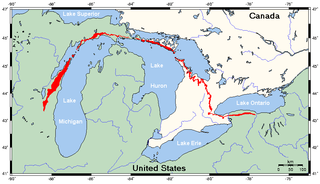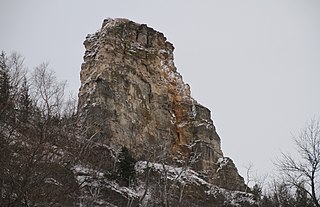| Mayville Formation | |
|---|---|
| Stratigraphic range: Silurian | |
| Type | Formation |
| Location | |
| Region | Wisconsin |
| Country | United States |
The Mayville Formation is a geologic formation in Wisconsin. It preserves fossils dating back to the Silurian period. It is the principle cliff-forming unit in the Niagara Escarpment. [1]

The Niagara Escarpment is a long escarpment, or cuesta, in Canada and the United States that starts from the south shore of Lake Ontario westward, circumscribes the top of the Great Lakes Basin running from New York through Ontario, Michigan, and Wisconsin. The escarpment is the cliff over which the Niagara River plunges at Niagara Falls, for which it is named.

An escarpment is a steep slope or long cliff that forms as a result of faulting or erosion and separates two relatively level areas having different elevations.

The Onondaga Limestone is a group of hard limestones and dolomites of Devonian age that forms geographic features in some areas in which it outcrops; in others, especially its Southern Ontario portion, the formation can be less prominent as a local surface feature.
The Oak Ridges Moraine is a geological landform that runs east-west across south central Ontario, Canada. It developed about 12,000 years ago, during the Wisconsin glaciation in North America. A complex ridge of sedimentary material, the moraine is known to have partially developed under water. The Niagara Escarpment played a key role in forming the moraine in that it acted as a dam for glacial meltwater trapped between it and two ice lobes.

Niagara Gorge is an 11 km (6.8 mi) long canyon carved by the Niagara River along the Canada–United States border, between the U.S. state of New York and the Canadian province of Ontario. It begins at the base of Niagara Falls and ends downriver at the edge of the geological formation known as the Niagara Escarpment near Queenston, Ontario, where the falls originated about 12,500 years ago. The position of the falls has receded upstream toward Lake Erie because of the falling waters' slow erosion of the riverbed's hard Lockport dolomite, combined with rapid erosion of the relatively soft layers beneath it. This erosion has created the gorge.

The Eramosa Member is a Silurian stratigraphic unit of the Lockport Formation exposed along the Niagara Escarpment in Ontario and western New York State. In the late nineteenth century it was an important source of building stone in Hamilton, Ancaster and Waterdown, and in the late twentieth century quarries in a similar unit, also called the Eramosa, near Wiarton in the Bruce Peninsula, became an important source of dimension stone at a time when most of the other resources of similar stone were depleted. Work in these quarries led to the discovery of exceptionally well preserved fossils. On the east Mountain at Hamilton, a well-developed cave system was discovered in the Eramosa and has now been designated as the Eramosa Karst Conservation Area.

Paleontology in Wisconsin refers to paleontological research occurring within or conducted by people from the U.S. state of Wisconsin. The state has fossils from the Precambrian, much of the Paleozoic, some a parts of the Mesozoic and the later part of the Cenozoic. Most of the Paleozoic rocks are marine in origin. Because of the thick blanket of Pleistocene glacial sediment that covers the rock strata in most of the state, Wisconsin’s fossil record is relatively sparse. In spite of this, certain Wisconsin paleontological occurrences provide exceptional insights concerning the history and diversity of life on Earth.

The Shakopee Formation is a geologic formation in Illinois, Indiana, Wisconsin, and Minnesota. It preserves fossils dating back to the Ordovician period. It is named after the town of Shakopee, Minnesota, where the formation can be seen in bluffs along the Minnesota River
The Lockport Group is a geologic group in the Appalachian Basin and Michigan Basin in the northeastern United States and Canada. This unit makes up the Niagara Escarpment. Its most famous feature is Niagara Falls. The unit outcrops in New York, Ontario, Michigan, Wisconsin, and Illinois.
The Franconia Formation is a geologic formation in the upper mid-western United States, with outcroppings found in Illinois, Indiana, Iowa, Michigan, Minnesota, Missouri, Ohio, and Wisconsin. It preserves fossils dating back to the Cambrian period. It was named the Franconia Formation due to the first published documentation of exposures in vicinity of Franconia, Minnesota in the 1897 Ph.D. dissertation by Charles P. Berkley at the University of Minnesota titled Geology of the St. Croix Dalles. The Franconian stratigraphic stage was named after this formation.

The Jordan Sandstone is a geologic formation in Wisconsin. It preserves fossils dating back to the Cambrian period.

The Oneota Formation is a geologic formation in the upper Midwest including Minnesota, Illinois, Indiana and Wisconsin. It preserves marine fossils dating back to the Ordovician period.
The Manistique Formation is a geologic formation in Wisconsin. It preserves fossils dating back to the Silurian period.
The Byron Formation is a geologic formation in Michigan and Wisconsin. It preserves fossils dating back to the Silurian period.

The Oread Limestone is a geologic unit of formation rank within the Shawnee Group throughout much of its extent. It is exposed in Kansas, Nebraska, Missouri, Oklahoma, and Iowa. The type locality is Mount Oread within Lawrence, Kansas. It preserves fossils of the Carboniferous period. Although it has significant shale members, its limestone members are resistant and form escarpments and ridges. Limestone from the unit is a historic building material in Kansas, particularly in the early buildings of the University of Kansas; standing examples include Spooner Hall and Dyche Hall.
The Windrow Formation is a geologic formation in Minnesota named after Windrow Bluff on Fort McCoy, Monroe County, Wisconsin. It preserves fossils dating back to the Cretaceous period.
The Holder Formation is a geologic formation in the Sacramento Mountains of New Mexico. It preserves fossils dating back to the late Pennsylvanian.

The Fort Hays Limestone is a member of the Niobrara Formation of the Colorado Group exposed in Colorado, Kansas, Nebraska, and South Dakota and is named for the bluffs near the old Fort Hays, a well-known landmark in western Kansas.
The geology of Wisconsin includes Precambrian crystalline basement rock over three billion years old. A widespread marine environment during the Paleozoic flooded the region, depositing sedimentary rocks which cover most of the center and south of the state.
The Beeman Formation is a geologic formation in the Sacramento Mountains of New Mexico. It preserves fossils dating back to the Kasimovian Age of the Pennsylvanian Period.